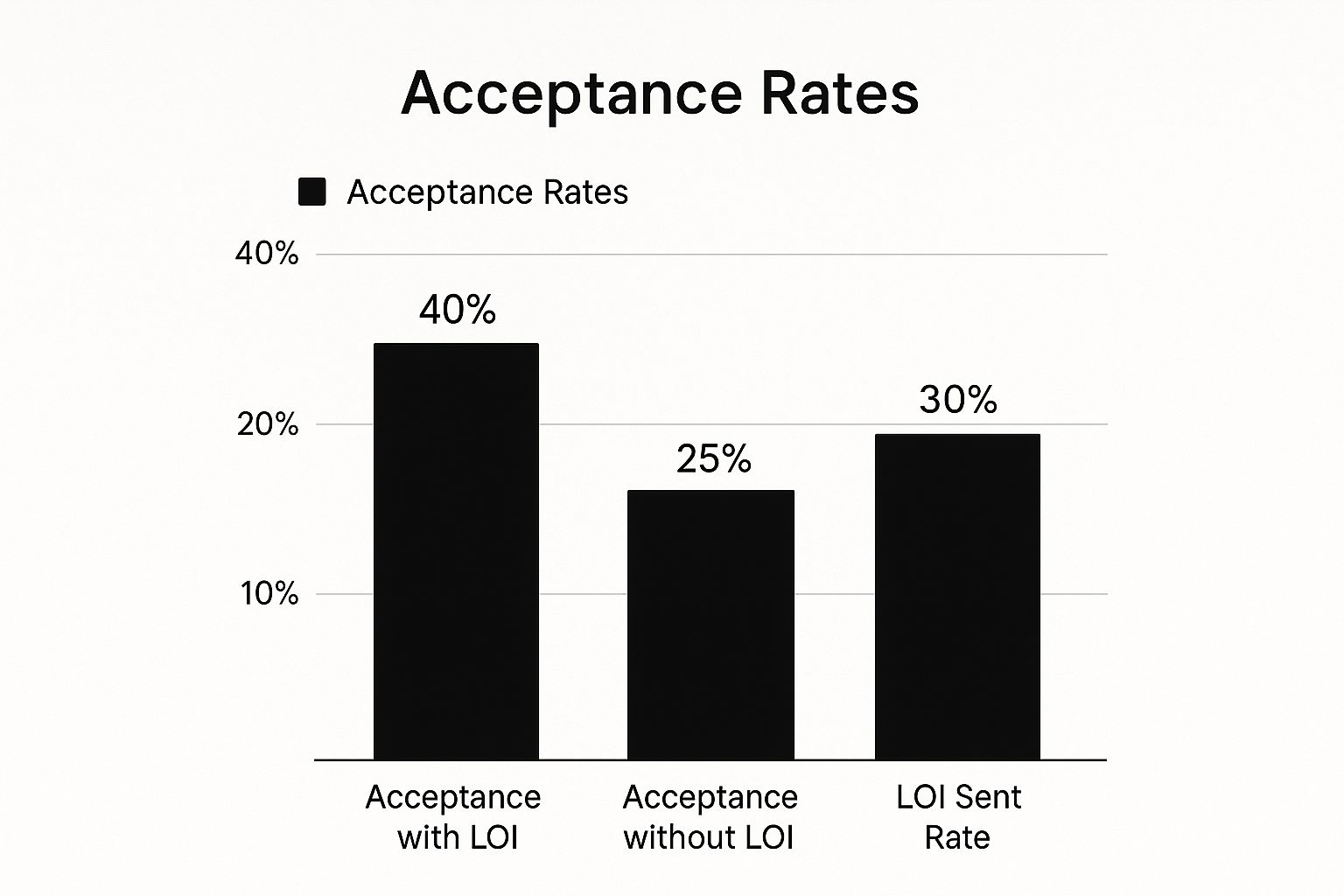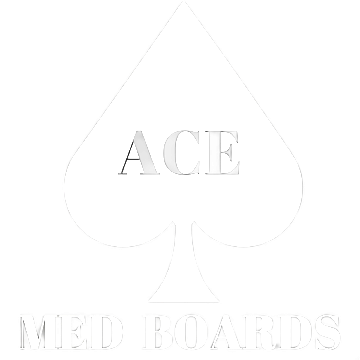A medical school letter of intent is a powerful piece of communication you send after your interview. It's where you formally declare that a single medical school is your #1 top choice. This isn't just an update letter; it's a strategic commitment where you state, unequivocally, that you will accept their offer of admission if they extend one.
When used correctly, it can be a huge factor, especially if you find yourself on the waitlist.
Why Your Letter of Intent Is a Game-Changer
You've made it through the months of applications, the gauntlet of secondary essays, and the nerve-wracking interviews. Now comes the waiting game, which can honestly feel like the hardest part of the whole medical school admissions journey. You've put your grades, MCAT score, and experiences on the table, but so have thousands of other incredibly qualified candidates.
So, how do you make one last, compelling case for yourself when the competition is at its absolute peak?
This is where a sharp, well-crafted letter of intent gives you a real strategic advantage. It’s not just another piece of paper to add to your file. Think of it as your final pitch—a direct message to the admissions committee that turns you from just another name on a list into a committed, enthusiastic future student.
Standing Out in a Competitive Field
The medical school admissions landscape is brutal. In 2024, U.S. MD programs had an average acceptance rate of just 4.23%. If you’re looking at top-tier schools like Stanford, that number plummets to a staggering 1%, with only a fraction of their nearly 9,000 applicants even getting an interview.
These numbers highlight a critical reality: great stats alone won't guarantee you a spot. A personalized letter of intent can be the very thing that sets you apart from other applicants who look identical to you on paper. You can find more data about the competitiveness of medical school admissions to see just how tight the numbers are.
Admissions committees aren't just trying to fill seats with qualified people; they want to build a class of students who are genuinely excited about their specific program. They’re aiming for a high "yield"—the percentage of accepted students who actually enroll. Your letter speaks directly to this concern.
- It Declares Unwavering Commitment: A letter of intent removes all doubt. By stating a school is your absolute top choice, you’re assuring them that an acceptance offer will be met with an immediate "yes."
- It Creates a Personal Connection: This is your chance to connect your personal story directly to something specific you learned about the school's mission, a unique research opportunity, or a community outreach program you discussed during your interview.
- It Demonstrates Professionalism and Follow-Through: Taking the initiative to send a thoughtful, polished letter shows maturity and a proactive attitude—qualities every future physician needs.
A letter of intent shows an admissions committee you've done more than just apply; you've envisioned yourself as part of their community. It’s a powerful signal of genuine fit and sincere desire to matriculate.
Before we go further, it's critical to understand the difference between a Letter of Intent and a Letter of Interest. They sound similar, but they serve very different purposes, and sending the wrong one can backfire.
Letter of Intent vs. Letter of Interest Key Differences
This table breaks down the crucial distinctions to help you decide which one is right for your situation.
| Aspect | Letter of Intent (LOI) | Letter of Interest |
|---|---|---|
| Primary Purpose | To declare a specific school is your #1 choice and you will attend if accepted. | To express continued strong interest in a school without making a definitive commitment. |
| When to Send | Post-interview, typically when you are waitlisted or deferred. | Pre-interview to boost your application, or post-interview if you're not ready to commit. |
| Commitment Level | Very High. You are making a binding promise. | Moderate. You are reaffirming interest among other top choices. |
| How Many to Send | Only ONE. Sending more than one is an ethical breach. | Can be sent to a few top schools you're genuinely interested in. |
| Key Phrase | "You are my number one choice, and if accepted, I will matriculate." | "Your program remains one of my top choices for…" |
Sending a Letter of Intent is a serious move—only make that commitment to one school. A Letter of Interest, on the other hand, is a great way to keep your name on the radar for several schools you'd be thrilled to attend.
The Tangible Impact of an LOI
Does this final piece of communication actually make a difference? The data suggests it can. The chart below gives you a visual of the potential boost a letter of intent can have on acceptance rates for candidates who have already interviewed.

This data shows a pretty significant correlation. It suggests that applicants who take the time to submit a letter of intent might see a real increase in their odds of getting in compared to those who don't.
Ultimately, the letter of intent is your final opportunity to remind the admissions committee why you are the perfect fit for their program and to solidify your place in their incoming class.
Anatomy of a Compelling Letter of Intent

A great medical school letter of intent is more than just a polite follow-up; it’s a powerful piece of strategic persuasion. To make it work, you have to understand how each part builds on the last to create a convincing argument for your acceptance. Forget rigid templates. This is about mastering the art of professional, heartfelt communication.
Let's break this critical document down, piece by piece. From the opening line to the final sign-off, every section has a specific job to do. Nailing each one is your key to convincing the admissions committee that you belong in their next class.
The Unmistakable Opening Declaration
Your letter's first paragraph needs to be direct and confident, leaving zero room for interpretation. This is not the time to be shy or use soft, indecisive language. State your purpose immediately and with conviction.
Right out of the gate, you need to establish two things: who you are and why you're writing. Include your name, your AAMC ID, and the date you interviewed. Then, deliver the most important sentence of the entire letter.
Key takeaway: Your opening line must explicitly state that this school is your number one choice and that you will matriculate if you get an acceptance. A phrase like, "I am writing to express my unwavering commitment to [Medical School Name], which is my top choice for my medical education," is absolutely essential.
Anything less definitive turns your letter of intent into a simple "letter of interest," which dramatically weakens its impact.
Crafting a Body That Connects and Convinces
The body of your letter is where you prove that your commitment is real. A generic "I love your school" won't cut it. You have to draw specific, meaningful lines between your unique story and the school's distinct programs and culture. This section should be about two to three paragraphs long and packed with substance.
Your goal is to demonstrate "fit" in a way that feels authentic and deeply researched. The biggest mistake applicants make here is simply rehashing their primary application. Instead, bring new insights and connections to the table.
What to Include in the Body Paragraphs:
- Reference Your Interview: Mention a specific conversation or moment from your interview day. Did you have a great discussion with a faculty member about their research? Did a current student share a story about a clinical rotation that really stuck with you? Bringing this up shows you were paying attention and that the experience genuinely solidified your interest.
- Connect to Specific Programs: Go deeper than the school's general mission statement. Name a particular research lab, a unique curriculum track (like a rural health pathway or a global health initiative), or a student-run clinic that aligns perfectly with your background and goals. For example, if you have experience with a public health project in an underserved community, connect that directly to a similar program at the school.
- Provide Meaningful Updates: Do you have a significant update since your interview? Maybe a new publication, a promotion at work, or a new clinical role. This is the place to share it. But here's the crucial part: don't just state the update. Explain why this new achievement makes you an even better fit for their program specifically.
The logic is simple: you’re showing the admissions committee that your decision is based on thoughtful consideration, not just a desperate hope to get into any medical school. The principles of storytelling and demonstrating fit are similar to what you'd find in strong application essays, like those in our guide to personal statements examples for medical school.
The Confident and Reassuring Closing
Your closing paragraph is your final chance to seal the deal. It should be concise, professional, and restate your commitment with absolute certainty. You want to leave a lasting impression of a mature, decisive, and enthusiastic applicant.
Reaffirm your intention to accept an offer if they extend one. A simple, powerful sentence like, "Thank you for your time and consideration; I would be honored to join the incoming class at [Medical School Name] and hope to hear from you soon," is perfect.
Finish with a professional closing ("Sincerely," or "Best regards,"), followed by your full name and AAMC ID. The principles of structure and tone are widely applicable, and for more tips, you might find some useful general guidance on how to write a compelling formal letter.
By carefully constructing each part—from the direct opening to the evidence-packed body and the firm closing—you create a document that doesn’t just state your interest, it proves it.
How to Demonstrate an Authentic Fit

Admissions committees have seen it all. They can spot generic praise from a mile away. Trust me, a medical school letter of intent that just compliments a school's reputation is heading straight for the discard pile.
Your mission here is to prove your interest is the real deal—deeply researched and specific to their unique community. This is where you go beyond the numbers and connect your personal story to their institutional soul.
Authentic fit isn't about regurgitating what you think they want to hear. It’s about drawing clear, compelling lines between your values, your experiences, and your future goals and what that specific school offers. This means you have to dig much, much deeper than a quick scan of their website.
Beyond the Website Mission Statement
Every medical school has a mission statement about serving communities and advancing medicine. That’s a given. To show you’re a genuine fit, you need to connect with the tangible ways they bring that mission to life. Your letter should feel like a natural continuation of the conversation you started during your interview.
Think back to your interview day. What really stuck with you?
- Faculty Conversations: Did you have a great discussion with a professor about their specific research? Mentioning that conversation and how it fires up your own research ambitions shows you were present, engaged, and are a serious contender.
- Student Insights: Did a current student share a detail about a unique problem-based learning module or a specific clinical rotation that got you excited? Reference it. This proves you were listening and can already see yourself thriving in their exact educational environment.
- Campus Atmosphere: What was the vibe? If the collaborative, supportive culture was something you could feel—and it aligns with your learning style—say so. Even better, connect it to a past experience where you excelled in a similar team-based setting.
Recalling these specific details makes your letter personal and memorable. It demonstrates that your impression of the school is built on real interactions, not just rankings. For more guidance on making a great impression during these crucial conversations, review these essential medical school interview tips.
Weaving Your Story into Theirs
Your letter of intent is the perfect place to share meaningful updates. But just listing new accomplishments is a huge missed opportunity. The real magic happens when you frame every update through the lens of the school's specific programs and values.
Let's say you recently stepped into a leadership role at a student-run free clinic. Don't just state the fact. Connect it directly to the school's known emphasis on community health.
Generic Update: "I was recently promoted to clinic coordinator at our university's free clinic."
Authentic Fit Update: "My recent promotion to clinic coordinator has deepened my passion for serving vulnerable populations, a commitment I know is central to your school's mission. This experience has prepared me to contribute meaningfully to your student-run clinics from day one."
See the difference? This approach transforms a simple update into powerful evidence of your alignment. A great foundational step for this is writing a powerful personal mission statement; it helps clarify the exact values you want to highlight.
Pro Tip: Look up the school’s strategic plan or recent newsletters. These documents often highlight new initiatives or faculty research that aren't on the main admissions page. Referencing one of these shows an exceptional, standout level of interest.
In today's hyper-competitive environment, this personalized approach is everything. While high scores are a prerequisite—the average accepted MCAT score was around 511.7 in 2024—they aren't the whole story.
At top-tier schools like the University of Virginia, with a 2.5% acceptance rate, a compelling narrative of fit in an LOI can be the very thing that distinguishes a candidate from a sea of applicants with similar metrics. It can genuinely improve your odds in a highly selective pool.
By grounding your letter in specific, personal, and well-researched details, you build a powerful and authentic case for your admission that no other applicant can possibly replicate.
Your Submission Timing and Strategy
A fantastic letter of intent can completely miss the mark if it shows up at the wrong time, gets lost in a generic inbox, or breaks a school’s rules. Timing isn't just a small detail; it’s a huge part of your strategy. Sending this letter requires a bit of finesse and a real feel for the rhythm of the admissions cycle.
The absolute sweet spot for sending your letter is after your interview but before the school sends out final decisions. This window, usually in the late winter or early spring (think February or March), is when admissions committees are finalizing their class and building their waitlists. Your letter lands on their desk right when it matters most, just as they're making their toughest calls.
To Send Now or Wait for the Waitlist
Figuring out the exact moment to send your letter within that window is a crucial strategic decision. Do you send it right after your interview to keep the momentum going? Or do you keep it in your back pocket as your ace in the hole, just in case you get waitlisted?
Sending Proactively (Post-Interview, Pre-Decision): This is a bold move that screams confidence and initiative. It can solidify a great interview performance and keep you fresh in the committee's mind while they deliberate. It’s a powerful play if you are 100% certain that this school is your top choice, no ifs, ands, or buts.
Sending Reactively (After Being Waitlisted): This is the most common—and often the most effective—time to send an LOI. When you're on the waitlist, a school is worried about "yield protection" (i.e., whether an accepted student will actually attend). Your letter solves that problem for them by guaranteeing you'll say yes, making you a much more appealing candidate to pull from the waitlist.
There’s no single right answer here, but a letter sent from the waitlist often has a bit more punch because it directly addresses a key concern for the admissions team.
A well-timed letter of intent shows more than just commitment—it shows you understand the admissions game. That’s a sign of maturity and strategic thinking that committees definitely notice.
The Logistics of a Successful Submission
Getting the technical details right is just as important as what you write. A professional, polished submission ensures your message gets seen and taken seriously. This is the last hurdle; don't trip over a simple mistake. Our comprehensive medical school application checklist is a great resource to keep you organized during this final push.
First things first: who are you sending it to? Don't just fire it off to a generic admissions email. Do a little digging to find the Dean or Director of Admissions and address the letter to them by name. If you really connected with one of your interviewers, it’s a smart move to CC them, too.
Next up, your subject line. It needs to be clear, professional, and easy for them to find in a crowded inbox.
Effective Email Subject Lines:
- Letter of Intent – [Your Name], AAMC ID: [Your ID]
- Regarding My Application – [Your Name], [AAMC ID]
- A Note of Intent: [Your Name]
Before you hit send, always double-check the school's specific instructions. Some schools have a dedicated portal for updates, while others explicitly state they don’t want any post-interview communication. Sending a letter to a school that has asked for none shows you can't follow directions—a massive red flag.
With over 52,000 applicants fighting for roughly 23,000 MD spots in the U.S. in 2024, every little detail matters. The overall acceptance rate is around 44%, but that number can be deceiving. The most competitive schools have acceptance rates well below 2%. In this incredibly crowded field, a letter of intent helps you signal that you're a high-yield candidate who will absolutely say "yes." For an admissions committee trying to manage their enrollment numbers, that information is gold.
Common Mistakes That Weaken Your Letter

You've poured countless hours into your application, secondaries, and interview prep. The last thing you want is for a few avoidable errors in your medical school letter of intent to sabotage all that hard work. This letter is your final, powerful pitch, and even a single misstep can send the wrong message to the admissions committee.
Even the most qualified applicants can shoot themselves in the foot with a poorly executed letter. Let’s break down the common pitfalls I’ve seen trip people up, so you can make sure your letter is polished, professional, and persuasive.
Sounding Generic and Impersonal
This is the cardinal sin of letters of intent. Sending a letter that could have been written to any medical school is an instant red flag. Admissions officers are experts at spotting generic compliments and vague praise, and it immediately tells them your interest isn't as deep or genuine as you claim.
Your letter has to be packed with specifics. Instead of saying you admire their "commitment to research," name the exact lab you want to work in and mention the faculty member leading it. This proves you’ve done your homework and have a clear vision for how you'll contribute from day one.
Hedging Your Commitment
A letter of intent has one job: to declare a single school as your undisputed #1 choice. Using weak or non-committal language completely defeats the purpose and turns your powerful LOI into a lukewarm letter of interest.
Phrases to banish from your vocabulary:
- "Your school is one of my top choices."
- "I would be very likely to attend if accepted."
- "I am highly interested in your program."
Your language needs to be absolute. The only phrasing that works is a direct, unambiguous statement like, "If accepted, I will matriculate." Anything less introduces doubt and dramatically reduces the letter's impact.
A letter of intent is a promise. Any language that sounds like you're keeping your options open tells the admissions committee that your commitment isn't real, making your letter ineffective.
Repeating Your Application Verbatim
The admissions committee has already read your AMCAS application and secondary essays. Your letter of intent is not the place to simply rehash that same information. Wasting this valuable real estate to repeat old news is a massive missed opportunity.
Instead, your letter should build upon your existing application. It’s your chance to connect the dots in a new way or provide meaningful updates. Focus on what has happened since you submitted your application or what you learned during your interview that solidified your decision. This keeps your narrative moving forward and gives them fresh reasons to be excited about you.
Getting the Tone Wrong
Finding the right tone is a delicate balancing act. You need to project confidence in your abilities and genuine enthusiasm for their program, but crossing the line into arrogance or desperation is a major turn-off.
- Confident vs. Arrogant: It's great to confidently state how your new research experience makes you a better fit. Just avoid any language that sounds entitled, like "I deserve a spot."
- Enthusiastic vs. Desperate: Show authentic excitement for specific aspects of the program. Steer clear of begging or overly emotional language that can come across as unprofessional.
Remember who you're writing to. Maintain a respectful, mature, and professional tone throughout the letter. You are communicating with your potential future colleagues and mentors.
Overlooking Proofreading
It sounds obvious, but you’d be shocked how many applicants sink their own chances with simple typos, grammatical errors, or sloppy formatting. These mistakes scream "lack of attention to detail"—a critical flaw for a future physician.
Get the small stuff right. Misspelling a dean's name or—the ultimate face-palm—addressing the letter to the wrong school is an unforgivable error. After you write your letter, let it sit for a day, then come back and proofread it with fresh eyes. Better yet, have a trusted mentor or advisor read it over one last time before you hit send.
For a quick summary, here are the key things to keep in mind.
Do's and Don'ts for Your Letter of Intent
| Do | Don't |
|---|---|
| State your commitment unequivocally ("I will matriculate"). | Use vague or non-committal language like "top choice." |
| Provide specific details about the school's program or faculty. | Rely on generic compliments that could apply to any school. |
| Include meaningful updates since your application/interview. | Rehash information already in your AMCAS or secondaries. |
| Maintain a confident, enthusiastic, and professional tone. | Sound arrogant, desperate, or overly emotional. |
| Meticulously proofread for any typos or errors. | Send the letter without having someone else review it. |
| Address the letter to the correct person and school. | Make careless mistakes like misspelling names or institutions. |
Stick to these guidelines, and you’ll avoid the common traps that weaken an otherwise strong application. Your letter will stand out for all the right reasons.
Frequently Asked Questions About Medical School LOIs
Once you get to the final stages of the application cycle, the game shifts. It's no longer just about writing a great letter; it's about making smart, ethical decisions. After you've nailed down the core components of a medical school letter of intent, a bunch of "what-if" scenarios will inevitably pop into your head.
This is where we get into those tricky, nuanced questions. Getting these details right can be the difference between a letter that seals the deal and one that raises serious red flags with the admissions committee. Let's clear up some of the most common points of confusion.
Can I Send a Letter of Intent to More Than One School?
Let me be crystal clear: absolutely not.
The entire power of a letter of intent hinges on its exclusivity. You're making a definitive, ethically binding promise that one particular school is your undisputed number one choice, and you will matriculate if they accept you. That's the whole point.
Sending that same promise to multiple schools isn't a clever strategy—it's a serious breach of professional conduct. The medical world is much smaller than you think, and admissions officers absolutely talk to each other. If you get accepted to two schools where you sent an LOI, you'll be forced to break your word with one of them. That can damage your reputation before your medical career even begins.
A letter of intent is a commitment, not a tactic. Sending more than one completely undermines its purpose and your credibility as a future physician. Reserve this powerful tool for your single, undisputed top-choice program.
What Should I Do If I Don't Hear Back?
You've sent this incredibly important letter, and now… crickets. The silence can be nerve-wracking, I get it. The most critical thing to do right now is stay patient and professional.
Whatever you do, don't bombard the admissions office with follow-up emails or calls. They are juggling thousands of applicant files in a massively complex process. Trust that your letter has been received and added to your file; it will be considered when the time is right.
If you're antsy, an appropriate next step might be to send a concise update letter about one to two months later, but only if you have a significant new accomplishment to share. This acts as a gentle, professional nudge without making you look desperate.
Should I Mention New Grades or an MCAT Score?
Yes, but only if the update is a good one. A new, higher MCAT score or a stellar grade in a tough, upper-level science course is exactly the kind of new information that can strengthen your case. These aren't just numbers; they're tangible proof of your continued academic excellence and readiness for the rigors of medical school.
When you include these updates, you need to be strategic about it:
- Be direct and clear. State the new grade or score right up front.
- Explain why it matters. Briefly connect the achievement to your fitness for their program. For instance, "My recent A in Advanced Biochemistry has further prepared me for the rigors of your curriculum."
- Weave it in naturally. Don't just list the update like a bullet point. Integrate it smoothly into a paragraph that also reinforces your fit with the school.
This approach ensures the new information supports the larger story of your commitment and qualifications, making your medical school letter of intent even more persuasive.
Navigating the complexities of medical school admissions requires more than just good grades; it demands strategy and expert guidance. Ace Med Boards offers personalized admissions consulting to help you craft a standout application, from your personal statement to your final letter of intent. Secure your spot in your dream school by working with physicians who have been through the process. Schedule your free consultation with Ace Med Boards today!
